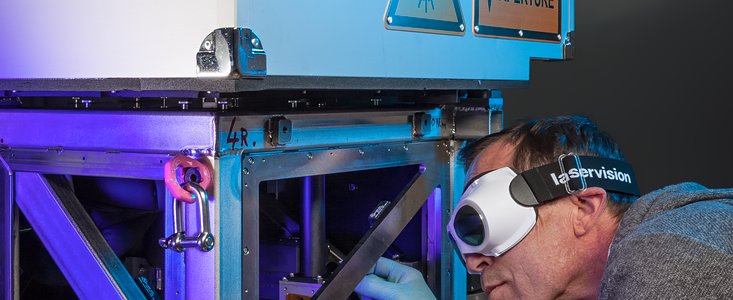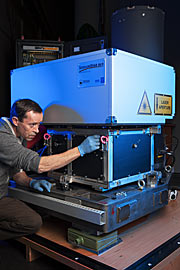Announcement
Laser Guide Star Units Accepted and Shipped to Chile
Four Laser Guide Star Facility passes key milestone
27 November 2015
All four laser guide star units that form the Four Laser Guide Star Facility — a core part of the Adaptive Optics Facility (AOF) for ESO’s Very Large Telescope — have now been accepted and are being shipped to Chile. This is a major step towards establishing VLT Unit Telescope 4 as a fully adaptive telescope with much enhanced image quality.
An adaptive optics system uses sensors to analyse the atmospheric turbulence and a deformable mirror integrated in the telescope to correct for the image distortions caused by the atmosphere. But a bright point-like star very close in the sky to the object being studied is essential, so that the turbulence can be accurately characterised.
Finding a natural star in the right place for this role is unlikely. So, to make the correction of the atmospheric turbulence possible everywhere in the sky, for all possible science targets, an artificial star is needed. Such stars can be created by projecting a powerful laser beam into the sky onto the sodium layer, where it creates a bright glow that appears star-like from the ground.
By measuring the atmospherically induced motions and distortions of this artificial star, and making tiny adjustments to the deformable secondary mirror one thousand times per second, the telescope can produce images with much greater sharpness than is possible without adaptive optics.
The first Adaptive Optics Facility laser guide star unit was installed on the VLT and successfully tested in situ earlier this year. These tests have confirmed the sound design implemented by ESO, in collaboration with European industry and scientific institutes [1]. Tests on VLT Unit Telescope 4 in Chile showed high optical quality, providing an almost perfect artificial star image, and high efficiency of the sodium layer excitation. These successes mean that the team can proceed with preliminary tests with GRAAL, the adaptive optics module feeding HAWK-I, the wide-field imager on Unit Telescope 4; all further steps towards the full commissioning of the Adaptive Optics Facility at Paranal.
The Adaptive Optics Facility will use four lasers simultaneously, which will allow better characterisation of the atmosphere’s properties — and hence a larger field of view where the image is corrected — than is possible with just one laser.
When fully installed, the Adaptive Optics Facility will feed light into two instruments, HAWK-I (in conjunction with GRAAL) and the integral field spectrograph, MUSE, (in conjunction with GALACSI).
Notes
[1] The companies involved include: TOPTICA, Germany; TNO, The Netherlands; MPB Communications, Canada; Optec, Italy; Astrel, Italy; and Laseroptik, Germany. In addition INAF–Osservatorio di Roma, Italy has made significant contributions to the project.
Links
- More information about the laser
- More information about the deformable secondary mirror
- More information about the laser launch telescope
Contacts
Domenico Bonaccini Calia
ESO
Garching bei München, Germany
Tel: +49 89 3200 6567
Email: dbonacci@eso.org
Wolfgang Hackenberg
ESO
Garching bei München, Germany
Tel: +49 89 3200 6782
Email: whackenb@eso.org
Richard Hook
ESO, Public Information Officer
Garching bei München, Germany
Tel: +49 89 3200 6655
Cell: +49 151 1537 3591
Email: rhook@eso.org
About the Announcement
| Id: | ann15089 |






